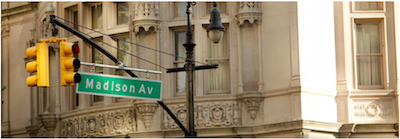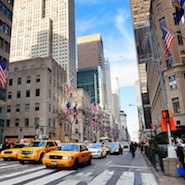Commercial real estate values have already peaked in New York, according to the majority of professionals surveyed for Marks Paneth’s Gotham Commercial Real Estate Monitor.
In just three months, the share of executives expecting values to rise has dropped from 43 percent to 31 percent, with nearly a fifth predicting a downturn in prices. The economy, new laws and even the growth of digital shopping all could play a role in future drops in New York commercial real estate.
"Our latest Gotham survey indicates that NYC-based commercial real estate professionals believe we will start to see values decline or at least hit a peak," said Bill Jennings, partner-in-charge of Marks Paneth’s Real Estate Group. "When a decline in asset prices is combined with a perceived decline in paper wealth, declines in rents are bound to follow.
"This effect serves as a double edged sword. Paying decreased rents will help a business tenant’s bottom line, but the perceived decrease in wealth may create a tighter belt for customers and therefore less consumer spending," he said. "The resulting combination of decreased rents costs but a smaller revenue stream may keep businesses in a stagnation period.
"Luxury businesses who attract the top one percenters as their clientele will be alright, but the ‘aspirationally wealthy’ customers may now bail on luxury items. Net/net, volume will be affected, and you may see a few 'luxury' shops closing doors."
“Gotham Commercial Real Estate Monitor” survey data is from 145 New York commercial real estate professionals, ranging across legal counsel, bankers/lenders, brokers, developers, property manager and owners.
Peaked value
Although the share expecting values to rise has contracted in just 90 days, the most common belief now is that values have peaked but will hold. Respondents overwhelmingly believe the market is overvalued compared to other cities, but 64 percent nevertheless remain optimistic for the next year.
The first of several potential factors in the peaking value of commercial real estate to be addressed is interest rates. The Federal Reserve has recently raised interest rates and will likely continue to do so as the economy improves.

Madison Avenue, one of New York's high streets
However, 46 percent say that even if rates were to go up by between 1 and 2 percent from today’s 0.5 percent, impact would be negligible. Only 11 percent predict a major negative effect.
This is particularly true on the residential side. The increase in foreign buyers has turned a number of the properties into safe havens, lower-risk alternatives than the stock market, where concern is for security rather than maximum yields.
"Residential markets will also feel a pinch as commercial rents/values take a hit," Mr. Jennings said. "This can be a positive thing, though. Property owners will continue to collect rents, even though they may do so at a lower rate and some may struggle through higher vacancy rates.
"As in any downturn, those who didn’t over-leverage equity in the good times will survive the downturn," he said. "For the tenants, lesser rents and higher vacancies will leave more of their money on the table, to be used for discretionary spending and other household needs.
"It is important to remember that this is a cycle that hasn’t changed - the residual income shift will benefit some and hurt others, but after every storm comes a rainbow and a time to reset."
With 55 percent expecting moderate to severe increase in foreign investment, this will continue to hold true. However, while the impact of foreign investors is largest with residential assets, at least 30 percent of respondents say it also has a “big influence” on retail, office and hotel real estate.

Saks Fifth Avenue flagship
Respondents are also split on the stock market, with a majority of 55 percent believing volatility will have a negative effect on New York commercial real estate, but a significant majority of 29 percent says the effect will be positive. The Monitor predicts that buyers from oil-producing countries will diversify from residential to office/retail properties, but that residential and hotel properties remain popular with China.
IRS section 1031 would cap the gain of a “like-kind” business exchange deferral at $1 million. Of the surveyed professionals that are also investors with active portfolios (more than half), three-quarters say the law will impact their strategy.
One additional cause not mentioned in the report is consumers’ shift in buying behavior. As retail growth moves to online and mobile channels while bricks-and-mortar sales stagnate, the significance of a New York location may decline.

Waldorf Astoria Park Avenue entrance
This reason may contribute to 31 percent of professionals claiming that the real estate is “highly overvalued,” with another 53 percent calling it “moderately overvalued.” As growth shifts to the geographically flexible Internet, prime physical location becomes less important.
Big city allure
New York is home to the most expensive retail real estate in the world, according to a November 2015 study by Cushman & Wakefield.
At $3,500 per square foot per year, Fifth Avenue from 49th Street to 60th Street, home to Saks Fifth Avenue, Louis Vuitton, Chanel and countless other luxury brands, is more than 50 percent pricier than the high street shops of Hong Kong’s Causeway Bay, which placed second. Real estate rates have risen amidst general economic uncertainty, but they are just one piece of the larger macroeconomic puzzle (see story).
Additionally, the North American market saw the highest concentration of private investment throughout 2015, with 32.3 percent of commercial real estate investments coming from private investors, according to Wealth-X research. Most noticeable has been the increase of inbound capital from Chinese and Middle Eastern UHNWs.
In 2015, outbound capital flow from Asia was expected to increase 61 percent as a result of policy changes in China and Japan that will ease investments, according to Colliers International.
This year, Japan will likely see an increase in outbound investments, as its Government Pension Investment Fund may allot 3 to 5 percent of its $1.1 trillion to global real estate. This would make the fund the world’s largest real estate allocation (see story).
"Let’s face it, shopping online is incredibly convenient, especially for our immediate gratification high speed society," Mr. Jennings said. "However, the changes anticipated in our Gotham commercial real estate surveys may be relevant for a retail-focused tech start-up as well.
"If commercial real estate rents do start to decline, a start-up may consider incorporating a larger brick and mortar component into their larger strategy," he said. "While digital e-commerce offerings have firmly established themselves in the retail landscape, even Amazon has implicitly acknowledged the importance of physical locations this as they look toward brick and mortar as an option.
"People still want a touch and feel rather than a two dimensional photo on a website, especially when it comes to non-technology products."
{"ct":"TufH03TesL44JWYzylsH7pPoG1syBl3uQ3ugA75P4ilqRWOghSuQyf0PVMESLMFNZJNE8+sl8TT06tSt+8WP+R1nnApgKJUHmSI7QUkRT1rpxG9JOrqmhfs4C95o+0XAnyiYThGkNzfRzbzcSEpwHjVRfsg7xLIEAtMzbIVbdQpfckpBdYwkJPsrarR2NkgyTOyTJaM3OKW5QlcpopH4iHfxqTx2qc8GBY+1Svy12uBEWHnpfCHBCZf1vNBDv4KmEXHKa\/bfolEaA7CLvlq6aHwb2UyLswV9yvMZIcYWYHBUrM\/tBseVo5M6OrZOnsRyjj5Qmxe6EhOcXOUsqjkDpvSWe0VXOZChsqMCrVUKJI3Ka7eScfAW8uZMvt6BNfF+CiWY3D\/KpVa1HQP3zzFKYUTE2NjUr4TcgZyDKRNkmCBBZnDgvlOHGzNjB\/nGFDsBuR8BcOFRJME7pHHcrV81oeIOgCA4Q0qw5x7MkZLjLMGU261je6c+ILuGwNAnlzwAgEfflV\/THHN\/qqhZCulsTMHpGWC0TRxOK7zD9\/N71lFM\/eGZ5rBwhU5wZHUR32ieci0XNI6kQPI0BP29RkBOiBbT18yD\/8v8SiySG5tFn41YG66ms09el7KxyyU+0Mq6Q389Ou5ufuA3fNbV+Bpp7SMEu3Eh9BvksXsIIb\/YxyFMIzlMnwVy99jTM0FMF+6Mu5JUxt7eqrtrfz8oB7QQ+lF3S0Zzu15tIPWBq97XPaKVW+x1GDeWPYbG4h47cnDBhO5eqPYDSTLgLZBkJBcKCAx+9mckQZ1br2jCEHs+wbsD0go1a0bT\/16jIEwyNje97LJXujbJVSrtt4sLJ8VxlgQ\/Swhx6+hx8Z5065sKRkhoMB3Eg\/spF2XJvdxW3T48ZCfF9xI4YbQYHOKObttGHcRBaYvQucQNsXKQBPj6DeFFkKcAWS0hz8fdtChu3RG0Lxw1GGeJCi2GjIZjFN6L20DLtrFdtYDWNJWj7aZiLUdaJnghInxsTes9ZGfF33ONWg5EnhpgKtfbIvZ0n14\/pox\/B0o+3WjNNROobBuTz4J53xoJpty4xyksvywPDkJthEnHVl9r4biWZWl37xwm2iXQndfqeA8mn\/lDZPtYcgTNMh\/Y9E71D5KjB\/4c4k7L4elKUJAfX1PxwsRKv4o7\/hJB489+T0sLQMSEbEgIPwc1YlC\/5aH8A730C70rM8DCq7ock6yRFaXtdvJDNnONgOQk6JhLPGRER7VUBWptRMiT6wNuQ3RuYK2OkJWDxDB2pqSmxNy\/SH6WJpiMJLCK8KIR3xroLwQ+mdkSU+lYJI0lMGpJeE\/J8qOVdMzsKS5BHjq36AO6oJn3gTzZWac5B1BFgRF\/PW6lWdTaHwvZVWoVS1vkWKDkyvy9kBYGx1KKV8SZqjLMsF8D+LFi7NQE9yIJZ3QYVhJvCWIqrC07dlMcMBl2AdP\/vRDDXmaisyrpuaGsCGSOjernMoPU\/FSBsBPzaP\/qXJwQoEZf8T2J8RGwShdHtF6L84PMLtYiPFQpcJKMfADOeYq2Y6wyG+b\/3ywl7hEUKx59VnUEnJY\/RLQ3jnBk0uuvuW0kua\/94Uo4f9pEwiHKIH2C+OkkSOfjE\/2MkYzOYGfUEUtnsP9ntMmGAeMFNo+NERKWSDA4b+MRnXBPWhSdZt8eVByySUFnr36EjfYSjl4RM0JIyxDtAjQJANwUNpjv9+Wh4i5Bffs6u7g+Y0x8WL4RX2Qx4T9PH\/QMIsDSMPpy5LBan5fZZJ90RAJ5LIQ8\/m5SD\/lsKO99Na\/itHfbNEGFnMe11hCApJrMusRbu8dqLFwUVtVqKyqyAncu2ehoxYw+VD8+aAH1sGuQ2n0IgkgztX3XsXZlWiSkTZVXbfbqkpXkw+K8HXZkv0Q44tbWhA2B181di1s6QqBzrqKut9E1P311EjOz8m3VhwTFB247XNOEd4AjGRW8mamNp746K+qCd28SU6EfnoglazQ4nik1fBpFHk1raZlQ8MRlHEWjWlCmVMFfIJ7lWDkITCb74jOKmdziSQyg1RCwg+AiRgM53VRKhXYx7gyh3B0w0nLec+9VncdUIG2RBJ8bOhP683Uut9d53SL1+sadz7moJNDnrrX7197GZeLN376\/YxVYRH23amhPOJBSQuNqCvVbJasDMfK7SFzoCjLoEm1TNMRRhMvl1yGLgeKdufgNRxG3PSxdHcToJ1olu70OUtt\/AEcsOYg8LbvTpLaD96wSklTiDNL71+dbWaQ\/q5\/mJlGSCE9OcYZpvYJHWaUi4FtYXlNb5HD+LKS1wSKSlYTCnZlEiBOonQwAI50PqQoMbFggEln\/9E0sfGy1kFUNzBM0BEqjrv6XFvC1H7gT\/bRgakWvAt\/OQFCJYwEx5WREHKFkuMLa0uq7ovhpgYiUY\/lYJs6i90CFIb0MC+Ecv1z+6dPCwlzWmX9IIku\/92QzauWN1JYkQvLN3l+9A18yhUo9W+Eajbk\/0P0FHsgGjPf9lciaWl0rBCX7wQX9PV6+seGAgINjitjJ7GB3Pxim+SsinpLdiHigM2HPu9zozWvidwm59SwQsIJ6o\/30orMB1x0rFWsm6yvvDQxmSrSiPJjeqAYdnlXQ6WISSU+jYtEqLdORosBFpB2hRKfPd\/bmi4O9SrJVdFocIMuTteaZYDjQ4jZhAw2Uy2516qgftozD8mgLS03OdbxuT5sAU8LokzNfdP64IcQcW8Q953WG7cmqhBBG0fRHjP7LUAGD5NF+KGysED\/yGKvvAN5frhRRj4qKR8yjRmf1iIk5jDJnIhUVnJg++Qmcva1bz8Lr2XvXqOdV\/PPaUUv8fsalt7kIMsFTxld5Nls3ZDG49MUCuB3ivlqSO9L+qC3707aHUdI+Pb6OrA8WY+g5W0ZaZssaItyYmq4iVvtNsehfHpMdZcnTr88n5zoNNbzvsCROWdvoV7bF60\/dSN4iAT1L2WEjA2DiUXWc7v3W3EVKpT+fkQUJtGrcWEov+erv9fd+uIw4T9wnCXykGTO9NUpvHuR9IlWOcQwNmh\/E1IfPw5gg0t4O36ub2x9dvW48lGuMdFpV4LlwaaxIpYg\/LWvVWjBrbvgqhfWy3586FHCNDiLXz4kUduiLN2S09xjw8lepjTUAC25w1eUkjsNIdLSnB7T173Nan7hRBuc1gXipvYiaLkyS7\/oDDuKOmw6FuiExNgouSEt6VqkZqnp0nTIymMhMFkkbh35fwIC2vHOWf7wJCEgk5mXhODPlRMV5qvLjn3rL88CsQUy5ZMhBWXTx9GWSbB2xktiERQBh+nSMBY\/FpwUJpsvFA5JYceOlbblDry\/G0cCzebYNeYt6P\/GBAGusB\/rH13J6XVzsniQxNygIvxCbPaLvCgmTybctuIAsDWLvfzBVOZEz\/SjqynPbZjwHA9W0DZGIHTUctMtZpwWqZUlvuKgb1VqT7cfFx0yUdKHJktQM\/btK8CxKVNeJlXYMi5dCKNfVZMEWaiRCC+EFb1sGQWxHSFcUvdqHJKMHCowvSPW8sTnzeX65ZLgNMzgobiHNblrKEcrZSyW0HKPv2X7r37ouImHowWHf6RhbWxH\/1z2RVz3iIofH+UXKlGijNa3OurZw4JF8gjFbQddKe0GXV6oL3LBNfXqO87TM9VhYMTPUqNuLurME0kBIP2enoR9nfSfNqtkAWiM1mDGzJjtie8zepb0gyOZtwba6VvZNQJKGak9IcioA1+KkM45Ax4z5jxQS4phuWnYAho12Sl9qaQl9TT0E5XrpITz3X+7xGRuRBwo675dhpUPOba\/YetxhYGX59eyhqkJCStqwG06eHe9R2zPR+ALgX+WsNwd+8hsPYAabZCMvGkpSfFg7wZ\/UWPA9JFUd8pFwQ0icQrgQL4gP8\/7Y+eh4hulj7yD+L6gl5h776IS4xIqMqCySwDuaR+kzGAzmrO8HBG9lv4Ev0hagajsDCvVGd\/tIl4BC+\/Bq+hI4UePgw4jSmYfUJ6pjvrbRVSbehjrm\/XRiRh3S2sjc8wAiUqwJ6QkgfHB8Be\/jzYteuUJM+yfIspco+ynU2uqjsVK6aPEE\/fX2s7t+dVvg4kGyooPoLxCVWAj2k9yqYvBL6hIQvZwqb7LEAk128IGcRx2nltsSoAmWL83\/ggwHNLh3QG5SEpnTDtB+ivRruatdHTApXGBbDiiy9nMhZ9obPLnvvjB1u5bLwgTLQq1zS\/Ql24m2ZQ6zQDn64umnPJRBfD8KRJROfS5R3pQT2bjLuQ3dGXDg1\/lAf96SUr6SETfMuJP\/Ri8FhQqY2KewhfThv+E86LFPzKVRnKIjGJOEDevVj+HRylzO9\/I5UIq010Ko7RpsJz397QxgDJJvFeadGJrLclu2Tjf3kw6BrHyqNkMsCImN\/gvV2p35DChyZztn9pGnWMMhegmcVnbs\/\/M7SA+LpNpnnpLz0X33GozHnkEVDsp6By6ha6XQCLPkAjSsBT+442\/5qtsUePnrN7vquYuH1e46CcSDv+PpasMN88fGszwrex7bGeA14MIDUBb0R4RlT+bgCC8w9lRxouGN4wYrDdQr7KTeg+VMEJO2fDQM\/sQV20Wxg6OZOf21UPLGIPxgqJpsU9V5Lv5NzD2+XBzweGbUQees9akW1kkz7KMrmODBcIyBRKwelTTVTtCyjfPlZTdaKPgedzuh\/1HIOIVprm\/6weBTSG5poW7Jb+66tBgIPJodDTTl77UJN9rRnJJHWZAycFVMocVlSTAq9+qBjRLlPZyg21glB6AnvXfvsBxcCpBxt17K+NoukMmwTyKHVjfkaa5aR4nJSBJHLxmS7KVsizUoQahGgC8bLGl5l\/yjuPBxmrCzOoQ0ex2vfjzrMQANuZk9YwQZ8yhgLy8sBCLLo3hPPSw2i7KKTpAUB4w0pjKQchkxsE9H1\/JKTfcxHoJQXp49H8w1NFAePJsrp7W9DaKhENLPSaI3eA8tWXOMqt+fYCv7Dp8k0ewHXHa6aWg4JYeKNL+KnO+591LAqeIEO8n1SrMT0XgOjPtXHjSiLIFxrXbI7M0ee7wnesJhZc\/ng1DUikOxlALnzqnMlfDItpqz\/MfX\/FkNRKox0HXOw2mPYFBtCp8li1Xhl0nGcTzrjnx8DuwxQmx9z3qB\/xH8iyC7Mf9+0P342azRITTopm3GX\/oFGN8GfSOOAoPuEAsZdJkdzCyL0pAHCA1a+0X86tsi\/ZIb8spfFNGNwNB5ZLC8m2fm+WMvjO8nG1zb4L2lDg5Mrq7P3xG712NsTadcyrWMxnoYepAK777\/6A1PyA+wFy8N29ve9Yxec1Zqy7gWJfBYBFIgOhKLZarxipzaDGGgdUDx843XUSW+AEVervbmf3GbwRn+v7gFSiXk0NN0eKyEtMzFItdFIgztAjIYFZ7PgIIUzxg0VRlN4cOuGzoBQvy7mu18dEKz+FGKvztiQt7CZnl2OQoQcw88Jtyl+Noj240UJB1cQKDAj5vPZuOUDvFvP6TEuGGSZjbtFkl9huw2cw0uj07Ru7as+NAM7e+NOY8hUFqItmYCtT45bTfsp+VjZNwBXz2i4lita5IOrJuw9aiXeIieIyJQT90m6o4lq02MJwFQiqsCgcL3SbZu2xA4ojQsFj1zYnKfhVQh5Q6rb+RSEgijtCS\/F1Pb7v7o2jQLv791lNT1vKLwHccmt6PkSZLKr33wxvJxEAZpWGB0o8+Glm8sygSNu8ABRU1g33xe5JamfWKjqb13jaUg97zm8oPIoiXX8Bw41S+DuXM6HDmjceiq5W2idqLSl7KyPW9AHPEHJ2QYm36RcHu\/bgKVVbe5amgILSLbq0Qprwcb6B\/yn4vk04oZg8xk2f4L1eywHXvr1CWWCyeg7+Q4bpBg8Pb1i\/WclLIesI75LbHCIett9aHohuKkOBQNVtD4ISz1gKZN3ohGnJffE11A\/9VpjmakqHvOY6ZoaiqwkYozKAbOMFSqUo8SrNyATXs4uXPkguZ2wT6VTiIEu5VStabILoqYiEQgsQ6kAbF+KiO+GTCzNGlJkIKYLMJ5s9S0axMOAEaFPX5WEBU4e1yQrAUVt5rvveO1ntTE1\/CKbnY+3r\/1h+lH5kmWSjUXMVsWWiI5\/Cnox\/X4sKydPYMGPX31ddWb4UvqUyHe\/Dd4Dnbi4RqBKNduYZ1XTBNUpyRjd3Fe2UdGLURAhpZThaAo8hjPwnK6ylXvwjf3RrsDNLveiVlW4UvPRd0Q4MPfdkJxijyWKNuf6e59YjI9kT16ElBONSGIGvwthb8mZQ1UkMgozfguUgnWP7rqmFakLp0m2d9lfvJgRX4wup6zXiEOQFvOuypZuSQv6XnHwBHpgHg26SqUgl8cJY5dLKsEQigygZmy9fTZwGZ7Me3oQW63H0OIdGVDS4yEsI\/K8iZVTWep7EFdGBk1K+UTbaLaeFP8\/ClbpbAk96T3c9dgVy+ye3G7nM583\/Uqs6f6CRJo+C7FPgqT4KhrzEaS+nBd+qk1C0wup78rHCqYzoKkfVJLjEKhFH3WtQMnKUvCDEywsU78yAZFssDtQhw4JrdXVBl58+oo2w9B1i4C56dozcFCK5oprrbQtc9+UJaV34WQJbr4lI0Q1MmJfnP9Qqs9YOi3HMXwIG258D29BDseaWuoHJsmTeBp\/CEOal0rsoaw+fDzIwb4rJ\/CNK2hbclUGXE6Ypoo6Y+PDpQELH865o7WDF3Mr7LWjl6LlML6S\/UwApSD+C94JU95v5M8cElw5SBWC5V4z2k95Ec2DhwLQ\/wGNzDfN2PpINuCqkPQNAmymftdgxYS0BNU8K2PBNdM9ldexndYsrAqugJwjOYiSxxBhZS1bCOSgypSbRmyMl8hMIskSyn2UMVwysDUdlNUCtgL9ejIJkrzl++FaCDd0d2SHyI+gOEcF\/oQWDnJCk\/\/dSfkZ\/K2DswmU0dSEZdHm8wCxsE5NbzwR7gl4xCpqiHWu+2vzXDadMfDbJfIOmDnVzrsm\/m8aLdBXZ4tKrPWT9sWOEGHT3hjblOo2o7vlO2QUgSKiEQ4X8FOGdokqSQNzPe\/esWrWKn2eyZqJZDn+GpemvAyF4GW7koBL1NdLzChm\/6kZ3CRZuGimz9Rg430iaQtUtv+fTdhinFLax0u3udYy2eAZgu0E6AgkWpnFQPVS+2a8o50TTK7VXobj\/pILDDrCzs0tMOB1+1\/GqwyZZx0mBT+MXW\/laXPs64IzEMkPVw6IBp3ihF4gVbccbVi03e2rspgRxigmg7\/KG8FAX+p1nTdpv0xmdnJfDQ+WIfjCI2lkS\/uoEz2GNUsXqXfbygD+Sf74cVgCMLdWMhFDQi4bvttRi1yqwcTUzafosm3KIA+6KRVAcJsirQhG7aQn\/aoKum8nGwvN+BCc5syLiNOCKFdqB15ULP+VIlj2AeLU0oRmArYHkjCI+75FjotfOy2uwPEv1WdKD9ho\/QXQIFH9pIE3qwwvSeK3Pmyzc9yuBLjMGwW3KLJVpadYJaXuZxIuj6pn5uO7\/dBjI9jJNW6FYgIuZxPXq7iKuRwquu\/CKNKo46v8E4bft3JWaltZhs+kEl0CdP9V\/ANP7noF76qAqJBmdC29IMPK6QIhIgjw7ogHGOJUZGySA2yaA5GEmWjONosUiLKGWwnKv9epoTVa8RfqCaHPgT8g5Wo\/SYRK\/nEgNRNWkZfdLP+ov4KJD1m3Gg8XMu6fqgqzj8KOPWMg9jdTSjteUnm6vfitQZCyJBjTGLjceMoB+ZCIQ+SrW0+BD+qlBYTn3kfo7uNk4rI3L5BpNUbXGQRDXDHobp4UAL41tWWPfs\/lQ1s+yhw4U8lcQfDAQJHdPYzS9wwf9dWYoQFNyPmBLylP7502UPgrmnuiQrP9LYXNh5Iy+UooB79X4kown0u\/c1nk5pa0YyeD2UdNQalszTwcwqoZ1ZKXUxHp9T3MIqDxet\/sNxlsT9nhGXmCHEtk3ZroUxfl9fgCujE10oPBtPeHBlO4Qew+ktMIkJC8Cpe4devmoS6SQJWG18sIcgX96VILVm8gK7QZ5Nh8VFypOMnZDxtSzkaCpeLv05S66zfA4FqUIS4Pty\/z4ff5\/tpElSoGNYO3sH0V2srrtTQ7dpGyvgLVFmXbDJT8BZC7j4W+o2B8gMdZmOK8ZTwRJcTFpq7nj8ysanaChR2hn63wnFJIwciRN8C3GiD4y+IDPPfyjIhkffKkyUXvAW6sEaajNc0pxav\/Zu8urrsXrbASUiUEU46G0AYxMA9U3g7mQ7HCA6HBFpkZTV2oB1I6OE1tnt\/kU9F43\/hU+tGrtOw89JDerpCUaLQj5YItMN739R+hs8XFAIMtz4PfkkyGg\/wtKPT40mOa8+AmZTyeShIuxcydvB+2\/XdIsfnlwm\/NHJzg7\/UKOaEgT0\/ulCU7pYftxpmJlt86xNXDZ27i56q6v2YgdKO6O6agy398Ob7NpyuKiqsw6pejGpJf1WS97NvSqVAzh\/4Ca75MaYSNeezcG4lt5RS2lhzwlQ5d7v1O45juQtIG820+rnnVl9XXlP5beB0Kd0QKoNsHlD4kUmjErjQzlU\/kvFz2K+H36dG5NV6Bmcwk+CpeEcTmobecU0XJZoDyHILTlhy1N0kotysiLy5x+7+nBJr6+QTKeuWIZOXoXi8V6UlCWq916lFeHaC8QVZMqST0aTNcpJUlWQI7oJj8tYJNQHcA0EYHe50zglCTOUWm7iq5Q3Lw49zJGv52iLPB\/asl9L5\/epoLC6qm4Q0iRY4OusMawFKKFdIj\/RkPxEdan\/9GrM6gKZGHdjyz9G\/TwxSL\/pslrhV+8\/mxHiaeV+hSb9qBly+3DKecpEQ6lJXhiimnckXSzaYSFsmVtS6z\/Xmip7v+z3UaRhC4YEJwfnUjk6v1QBw8dgwK6GBNJrHYsrV946IV19SAs79+HP0ae0vgCBUlu5YMuq5rsM4XPiuo9dPb\/AoU9E6\/eRBF9PFDvMnGxodgJbZN7Eo9NEEmpjcK2AXyVv17k2wDgTun\/Trhh2Y6TrE1qh5Hi2djiksKiDryFYjYPh6xMAlQ\/crSvB8MIosrCMDeW7AbOp8SIAMDRtYVGZbzbStBTWPoocDVCjW+CfnWgHwFizEtgDJi036JoVqiGSNyWAZZKKmzM29rs5T0D8T59xkWNziB5hc\/9MP4Cyc03G8FMD6N\/ACMXcpfy2bFTiEfjoF7vCtu+UmAVWjN4h8nGYn2x+ChvuchHPsraTFwYc7WFeV5UK3fos7VwAYWy75dMzqvPULUzWhO6ISt5H5OiAQWCX\/6xkien7PPb4rECbJ1chzxmfbK0dw8+SQCKcDO5n4W340NfRQM5UUJ3Oo7TMhT1tPyj+iu9iq9RM0xUtotIeGO8QP2XZRoheJYXQhL3t60IoEU1zXkOdHnqMOnsNL6m25g2JUPo9OWWY4aTlTNe7Ee4oxoZhAlFoO6GiT\/ffIpo12gJLFwZdT14286PHtP\/LS2qI+5XQh6gKIFLqDoJRu0ysO\/ZKRIjvUH5ExX1iN3qIwAciziwmRZfkHjDUh4c9JuN0iClPJclBCwvRbBcRb\/Rhj51ARXuhwNYwtZAdg\/8Z9hhY6UmyczpWiVFaLmAJA8ckKcbR+4ucfuFUdQ4OQp\/dhdIE3OE0Ww8Q4qVtOPnGUJWHm2uPwQ3a0HVHwfxS8S8BOnep+F\/NxWw+Jd+fwAf1JC4BgqXgAAFd\/ZFtYu9GU1Z8wMDovx49mcjmMbvD3hkqBx7BMirzoZCAjeKfWZv1M2NDnMbEI6kr8exhaZ2h9IxJZEPGYB6Ef7YEQeUDSbPXusr4vCFvwDR\/gT\/XljCpasqCLT4yP6S4AkH4dGVkQPzkq4gskgVZ8iTmfsPV7\/JNMjLssip\/C4gs\/Ef1+TC2wtwMMxz+IyhyxbbkTVo4tuZUPn48AiyzA\/lrzP\/KGjS4\/Mk\/gJBaK\/tOxXH49ta9RK1XD+hiQRgHELlcqLClP8RvsGiFivAuhP3h\/HEKFoyR8q+V+mefIKSA4f37B\/uKp9EduETufQs402Z58EQAmZQq8h++uScDfbzlbicRaNzIYGE6U+KQwGm7tycTLPjspaahqFefXcDQcXOQFTn4WzjUoG7t5tbdUkxve+yIfcpJgLNXvFiZtbdY65yEXWWvrsqfubn4DfIfZF8X09zt3wRj6wRvci52Fpl3xJAs55gUUWdpapcgwrXCoT2vaCPYaIplmvX37\/OcdYKZaVTRnAP\/np5mzg\/ljTaWYIx5uRhqDP3f\/Nnwd2FKKBBLGo2VRiqrXVp9wbhasbNiJHvMXFMy\/uZ5a3u5AxgkfEHDJ39y+3FLvee5jIqgt815IbZ9\/K74rzvv+b1ZfK752K7aPZJcQx7sbyBUjEDjdyfNrqhJHjdyAW6KBR++JhHuzLOnzmpsZkU88bAvy2bWgclbPZTXMg7jDLSv8F73+FplkW+sWobyBB63uf9V4t4N3U+VkH8h4NUasbZLZROSKRYvLyIEOc\/qLychQBmiSd1oMkKfZvo7T1PgL9dTlhWKMdvU+iwrKK1Mi+N+aULDBse6bSga9OB2rJl72oN2eUlxxMs1+\/mpo2V+wfAWgvqurP9FqCNRDu2k5HPXEIsguTGbqzasFwH208kbwqQ1ZVDvWlkWI0Bs6LLhhPwUXqK5vHepOeiiai\/CQnOQjUJZaRgc\/+aYgy8NneJDU4kCV9qtrM\/i9HgJs2S97xJw3cSslzjUupk6Ycgj9TkZY8r4oe2FDgJgYXIpQ+U7FFRaRFKNgIKDwn9b775BkGFQMa6FDdlI9w7n7KV3MtfUTWVD52NJM4i9VYzGrP7dvBnREYQj8vWgjIEaX+MeDyu4zcKxD\/9rgfQFMGUda5Dxthb1royrkXl7Vl9IPNZ7Yu5vaSrpKfAiJFbcXfmiWX6mk0Gbt0586NdtIEuBLT0VGtKJAbz9Rx1QmjTt+3BonPj48XTba0XtCAjL74a5cy8PQMdid73xqs4rYOb0IArpx8ETkXh+hVeEO7G5Z+CNNScsyBeaw78tS4OADKHp74tD3rhUEzPUA0QzdZxRU3x5yjDnDeErYd9FThV3Wh3nSCP6pw5cK4CEfjhD1puYMgH9YtsQHB22sNBomtKCXTjLGYZ54jiKCiL\/xr\/35\/Qr2zF7MIA4+Yv7IaweOK1Hi7A3V+O2QIrfXz65SokM9MI\/BrdXVfU0YV4uQlbv6MJ0oMUrX7BT76e3mS2tnjE3r5Z+gVz+DrD67gePVJH39yIdCsPCTmSgamo2c8CpXmW6NKcmm1o6OqLL4Ocw34G\/sD1G6VSBWuqOBPBvUMsA+QRboAux+NTCTGu9JRyXkEu9Mx\/pXQFW2czGCPBDbxWgcrG9P03LVZLfdf6MP5i47BvCyNiniH2kvtlSxwRytlZ\/LepWlOfTMzQCa2A5Ke2c8hJC96ZvR7\/5gYqeGqzhip2njLfcUk9X+z\/\/aayUiRepBdD2qSueVSZ5FYDhCcRHi9pjNUUSeDMIg\/JVb6bGXESnuvikGJIv8L+xC7bFzos4JUnYGZ7utRQOVoyTLj4xefTj98GyCaqBexORubBoSjyF+GPVkLCTqwLNrRz7QBgqbLdR67XNbdB3s1iUekG\/lBXKb6nfoWEpRKyKX9EDE8PFhc5yBEwe9nXthKdkUeSS7xL58AmYOo\/gbFV\/Re5QSE4+QXnvAOoVQ2B9nPWhc\/5L7YSbUNqsnez6lrV3oRb79R2UUjQ9IMRejc\/gZ2DkI8TaX0FCzdT\/KzWP53CTJx\/+MxwaSwTo6+fFf+wDsotfRBRumitnU7d+Ye3MZy80uzzKgd4QcKu3uHAds9zHwkUzQomCZwwCoqXshWHQzNEX\/tzJrhgLXEbd5p0LVY9hkhNOcYqiV+N5896WSFuhp95Iw\/w+igDu90uyeXlrXyBpkCARrP6w3f8SM2off8qMfu3xu9eQaOtKWkwtA1SjWOf338D23LuBmnk6JkCS0VuCGuAgfyGMuQlF3dFHnWSOTPeuPbIIg5G+9ExAopGUI6RrZlmPAq217bEQWTIy6YNiplahQaslHEteoWHIPpfIFbHf9fpMMqgbOjCXda38p9yrWLOElFrZS\/IL\/OcE3dSOmxvEIKLpwX6Uv4smSo4e9Mp\/MN4GU5pdKjbCIR7LYaTXKGSXsEARHutXzd9VIETVCWm5aJsAYrEW1RdGCJTW27kjGoA43IC5CG0PqvkT2n\/qNggbS7jVYTzINnrdDAIFURocQixpL4NXvVAsSTaBfShZDJknJBehnV\/x8obaAGqngbkT1ZSJVWNXeOUUyarUsN1A+NTSgcDWEWITofq09at1121nWkDW+Vm8A2xvs2ElTCfvER0l6ne2\/0S+0G+fHli++9\/MjiwpNX+KInT2zzd+FcCtqBtyDLw==","iv":"38d36b1ef6740e40a8f87788e4ce22bc","s":"81e8744638bf876d"}
